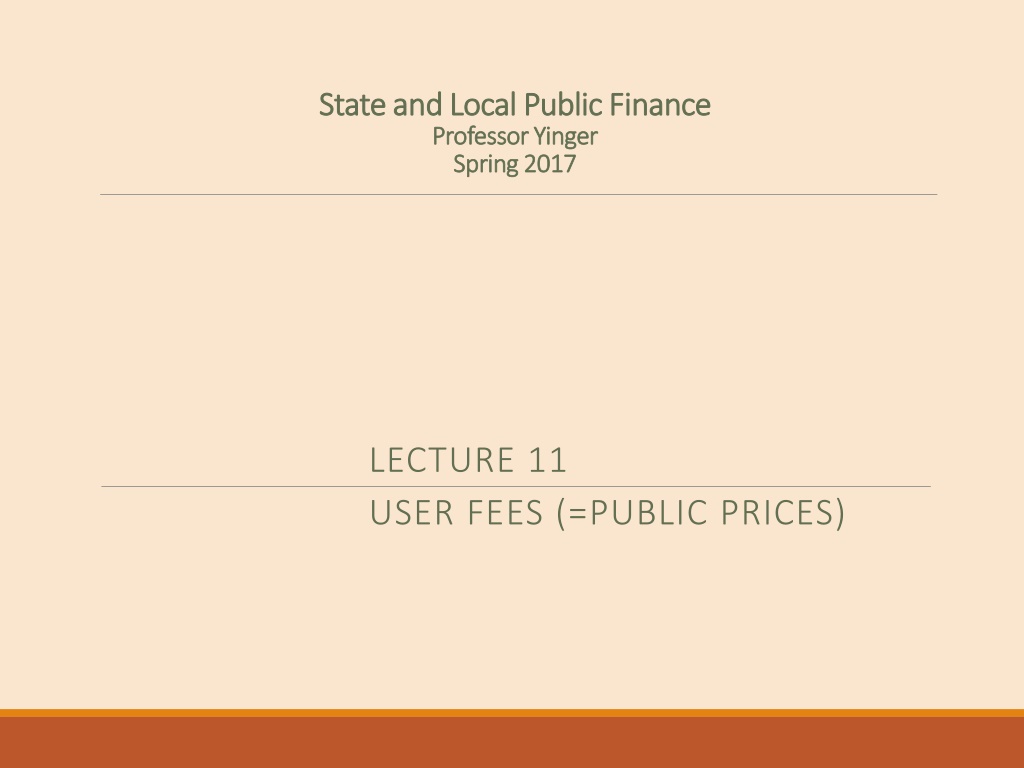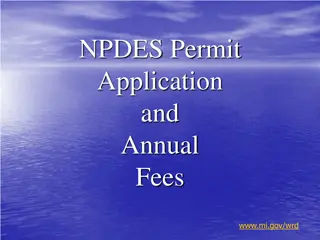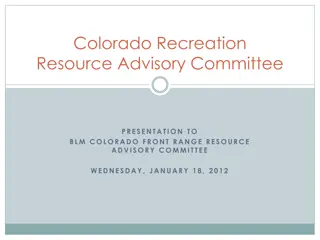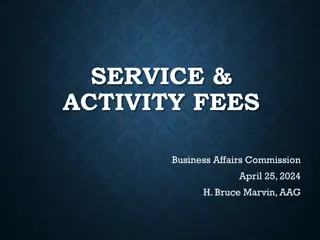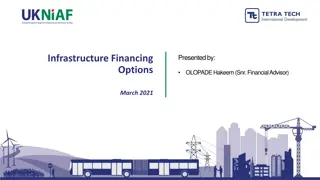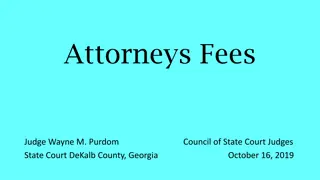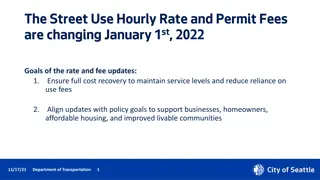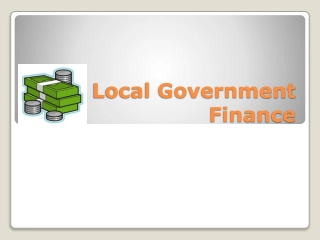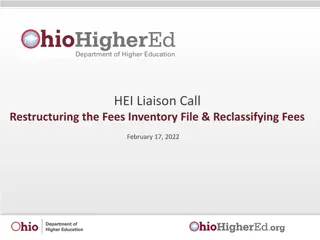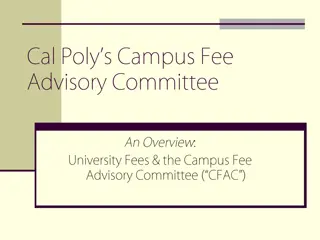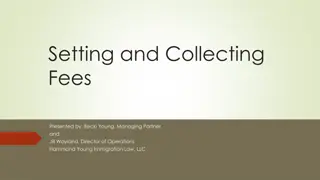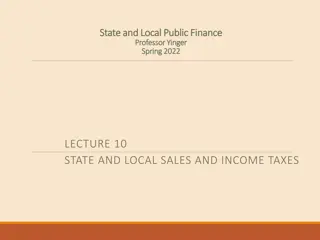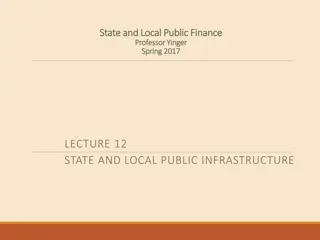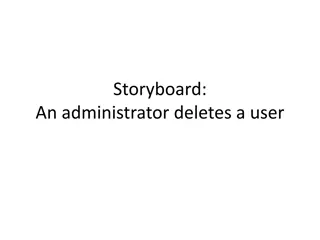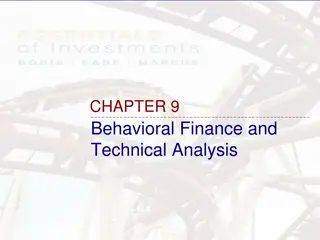Understanding User Fees in State and Local Public Finance
Exploring the concept of user fees as an alternative to taxation in state and local public finance. Discusses the justifications for public pricing, the basic rule for setting efficient prices, equity and efficiency considerations, and the importance of aligning prices with marginal costs for optimal resource allocation.
Download Presentation

Please find below an Image/Link to download the presentation.
The content on the website is provided AS IS for your information and personal use only. It may not be sold, licensed, or shared on other websites without obtaining consent from the author. Download presentation by click this link. If you encounter any issues during the download, it is possible that the publisher has removed the file from their server.
E N D
Presentation Transcript
State and Local Public Finance State and Local Public Finance Professor Yinger Professor Yinger Spring Spring 2017 2017 LECTURE 11 USER FEES (=PUBLIC PRICES)
State and Local Public Finance State and Local Public Finance Lecture 11: User Fees Lecture 11: User Fees Class Outline Why Use Public Pricing? The Basic Rule for Public Pricing Peak-Load Pricing Complexities of Public Pricing
State and Local Public Finance State and Local Public Finance Lecture 11: User Fees Lecture 11: User Fees Why Use Public Pricing? Public pricing, i.e. the use of user fees, is an alternative to taxation. It has three key justifications: 1. Some public monopolies are used as revenue sources (the subject of the last class). 2. The benefit principle justifies linking payments to the people who use a service. 3. Fees are needed to ensure efficient usage of a public service.
State and Local Public Finance State and Local Public Finance Lecture 11: User Fees Lecture 11: User Fees Equity And Efficiency Today we focus on setting efficient public prices, i.e., prices to support an efficient allocation of resources. Public pricing often raises equity issues, as well. o In some cases, high prices may discourage the use of a public facility, such as a zoo, by low-income groups. o In other cases, high public prices may hit vulnerable groups hard. An example is the impact of a subway fare hike on captive riders, namely, low-income workers who cannot afford a car.
State and Local Public Finance State and Local Public Finance Lecture 11: User Fees Lecture 11: User Fees Basic Rule For Public Prices To promote efficiency, a public price (P) should be set equal to marginal cost (MC). If P=MC, then consumers base their usage decisions on the true resource cost. As in a private market, decisions based on true resource costs lead to efficient outcomes.
State and Local Public Finance State and Local Public Finance Lecture 11: User Fees Lecture 11: User Fees Basic Rule For Public Prices, 2 P Consumer Surplus D=MB Peff MC Q The basic rule for public pricing is that the efficient price is one that maximizes consumer surplus, namely, a price equal to marginal cost (MC).
State and Local Public Finance State and Local Public Finance Lecture 11: User Fees Lecture 11: User Fees Basic Rule For Public Prices, 3 P Consumer Surplus D=MB MC Peff Q The basic rule may be difficult to apply; if MC is not constant, the rule cannot be applied without knowing the shapes of the demand and MC curves.
State and Local Public Finance State and Local Public Finance Lecture 11: User Fees Lecture 11: User Fees What Is The Margin? In some cases, the margin is not well defined and some judgment is required. Consider the case of public transit. o One could say that the last rider is the margin, in which case MC is essentially equal to zero. o One could say (more reasonably) that the last bus route is the margin, because that is what the provider controls, in which case MC could be set to the cost of the route divided by the average number of passengers.
State and Local Public Finance State and Local Public Finance Lecture 11: User Fees Lecture 11: User Fees Special Cases Pricing rules need to be adjusted in the presence of: o Externalities (which, as discussed in an earlier class, also affect taxing rules). o Variation in usage over time, which is usually called a peak load problem.
State and Local Public Finance State and Local Public Finance Lecture 11: User Fees Lecture 11: User Fees Public Pricing With Externalities P Consumer Surplus D=MB MC MC-MSB Peff Q When a public service generates positive externalities (such as lower pollution and congestion on roads due to public transit), the efficient price equals MC minus marginal social benefits (MSB).
State and Local Public Finance State and Local Public Finance Lecture 11: User Fees Lecture 11: User Fees Peak-load Pricing $ MSC Capacity PPeak DPeak POff DOff Number of Trips When congestion drives up the marginal social cost (MSC) or travel during peak times, the efficient price for the peak period (PPeak) exceeds the efficient price for the off-peak period (POFF).
State and Local Public Finance State and Local Public Finance Lecture 11: User Fees Lecture 11: User Fees Peak-load Pricing & Capacity This figures holds transit capacity constant, but this capacity (and hence this pricing scheme) might not be optimal in the long run. The optimal capacity is the one at which the marginal benefits equal the marginal costs. This is an example for the next class! A pricing scheme consistent with this capacity decision is given in the following figure.
State and Local Public Finance State and Local Public Finance Lecture 11: User Fees Lecture 11: User Fees Long-run Peak-load Pricing $ PPeak LR-MC SR-MC POff DPeak DOff Number of Trips When extra capacity must be added to accommodate peak travel, a pricing rule that recognizes the capacity decision is to set the peak price at the long-run MC, which equals the short-run MC plus the marginal cost of added capacity.
State and Local Public Finance State and Local Public Finance Lecture 11: User Fees Lecture 11: User Fees Optimal Departures From MC Pricing Covering a deficit for a natural monopoly. Responding to distorted prices in related markets.
State and Local Public Finance State and Local Public Finance Lecture 11: User Fees Lecture 11: User Fees Pricing For A Natural Monopoly P D=MB Deficit with MC Pricing Peven AC Peff MC Q When the government service is a natural monopoly, setting P=MC results in a deficit, which must be closed with tax revenue or by raising the price! The trick is to find the least distortionary financing method.
State and Local Public Finance State and Local Public Finance Lecture 11: User Fees Lecture 11: User Fees Ways To Cover A Deficit Use the break-even price (AC pricing) Use non-distortionary taxes Use distortionary taxes Set different prices for different services Use a two-part tariff Use some combination of the above
State and Local Public Finance State and Local Public Finance Lecture 11: User Fees Lecture 11: User Fees Average-cost Pricing P D=MB Lost Consumer Surplus with AC Pricing Peven AC Peff MC Q Using the break-even price instead of the efficient price covers the deficit, but results in a loss of consumer surplus.
State and Local Public Finance State and Local Public Finance Lecture 11: User Fees Lecture 11: User Fees Covering A Deficit With Taxes Non-distortionary taxes would be optimal, but they do not exist. Even a head-tax distorts the decision about where to live. A distortionary tax is a good option if the excess burden from the tax is less than the lost consumer surplus from AC pricing. Taxes may violate the benefit principle because they are not limited to people who use the priced service.
State and Local Public Finance State and Local Public Finance Lecture 11: User Fees Lecture 11: User Fees Pricing With Multiple Services Recall that excess burden depends on the price elasticity of demand. = 1 2 ( ) ( t ) 2 EB e PQ 1 1 For any two services, i and j, prices should deviate from MC according to the following rule: P MC P P MC P j j = e e i i i j i j
State and Local Public Finance State and Local Public Finance Lecture 11: User Fees Lecture 11: User Fees Deviations From MC Pricing With Two Services P Palt Palt Peff Peff MC D MC D Q If a government provides two services, it can cover its deficit with less distortion if it sets a higher gap between P and MC for services with less elastic demand (unlike this picture!).
State and Local Public Finance State and Local Public Finance Lecture 11: User Fees Lecture 11: User Fees Two-part Tariff Some services involve stages, such as buying a phone and then using the phone. (This used to be a public sector business!) These two stages may involve different elasticities. o For example, almost everyone used to buy a phone, but the number of calls clearly depends on the price. o So using the logic for multiple services, set a higher deviation from MC pricing for the less elastic stage (buying a phone).
State and Local Public Finance State and Local Public Finance Lecture 11: User Fees Lecture 11: User Fees Distorted Private Prices Efficiency requires consumers MRS to equal firms MRT for any two goods (where MRS is the ratio of the marginal utilities for the two goods and MRT is the ratio of their marginal costs). Competitive markets achieve efficiency because consumers set their MRS and firms set their MRT equal to the same market price ratio for the two goods. The P=MC rule simplifies this by looking at only one good, implicitly assuming that all other goods are priced properly. But if other goods are not priced properly, this simplification is not correct.
State and Local Public Finance State and Local Public Finance Lecture 11: User Fees Lecture 11: User Fees Distorted Private Prices, 2 We will examine two cases with distorted private prices: o An externality in a private market that is related to the government good being priced. o A private monopoly (or, indeed, any kind of market power) in a market that is related to the government good being priced.
State and Local Public Finance State and Local Public Finance Lecture 11: User Fees Lecture 11: User Fees Case 1: Externalities With a negative externality from the private good, the private price falls short of MSC. Thus, if the government sets P=MC, the ratio of the government to private price is above the ratio of the government to private MC. Because households respond to prices, P P = G MRS MRT P
State and Local Public Finance State and Local Public Finance Lecture 11: User Fees Lecture 11: User Fees Case 1: Externalities Because the price ratio is too high, consumers under-consume the public good relative to the private good. This could be fixed by pricing the externality in the private market as in the gas tax case discussed in an earlier class. Or by setting a price for the public good that is below its marginal cost.
Externalities Example Automobiles cause pollution and congestion, which are not priced. Drivers pay the gas tax, but (as discussed in an earlier class) this just covers road maintenance. Thus the price of driving is below the marginal social cost. One way to fix this is to lower the price of public transit below MC.
State and Local Public Finance State and Local Public Finance Lecture 11: User Fees Lecture 11: User Fees Case 2: Private Monopoly A private monopoly sets the price of its product above MC. Thus, if the government sets P=MC, the ratio of the government to private price is below the ratio of the government to private MC. Because households respond to prices, P P = G MRS MRT P
State and Local Public Finance State and Local Public Finance Lecture 11: User Fees Lecture 11: User Fees Case 2: Private Monopoly Because the price ratio is too low, consumers over-consume the public good relative to the private good. This could be fixed by regulating the monopoly s price Or by setting a price for the public good that is above its marginal cost.
State and Local Public Finance State and Local Public Finance Lecture 11: User Fees Lecture 11: User Fees When Pricing Principles Conflict Pricing decisions can get very complicated. Consider transit fares: o Raise fares to eliminate a deficit. o Lower fares to protect captive riders. o Raise fares at rush-hour to account for congestion on public transit. o Lower fares at rush-hour to account for the positive externalities of transit (lower pollution and congestion on highways) and the unpriced externalities (pollution and congestion) from driving.
State and Local Public Finance State and Local Public Finance Lecture 11: User Fees Lecture 11: User Fees When Pricing Principles Conflict, 2 The key lesson: One cannot achieve many objectives with one pricing tool! In general, a policy maker needs as many policy tools as objectives: o Raise fares to lower a deficit (and/or raise taxes to pay for transit since the entire area benefits from the transit system). o Provide discount cards for low-income people to protect captive riders o Use peak-load pricing to account for congestion on public transit. o Raise parking fees or raise gas taxes or charge tolls or implement a rush-hour pricing scheme in some zones (as in London or Singapore) to address pollution and congestion.
State and Local Public Finance State and Local Public Finance Lecture 11: User Fees Lecture 11: User Fees Income-based Discounts The New York Times, February 28, 2015 Seattle: ORCA Lift gives discounts on public transportation to people whose household income is no more than 200% of the federal poverty level. Subsidy is over 50% of peak fares. San Francisco: Muni Lifeline has fewer than 20,000 card holders in a system that serves about 350,000 people a day. Green County (near Dayton): Social service agencies buy travel vouchers and distribute them to their clients.
Transit Fares In NYC Unlimited Ride MetroCard Pay-Per-Ride MetroCard The more you ride, the less each ride costs. 5% bonus on purchase of $5 or more All free transfers included. Free subway-to-bus, bus-to-subway, or bus-to-bus transfer within 2 hours of paying your fare. (Some exceptions apply) Refill as often as you like, until card expires. Refill as often as you like, until card expires. Can only be used by one person at a time. Can be used to pay for up to 4 people at a time. Cannot be used again at the same station or same bus route for 18 minutes.
State and Local Public Finance State and Local Public Finance Lecture 11: User Fees Lecture 11: User Fees Transit Fares In NYC, 3, The Reduced Fare Cost: The base subway or local bus fare is $2.75. Reduced fare is half the base fare, $1.35 or less with Reduced-Fare MetroCard discounts. Who s eligible: Customers who are 65 years of age or older or have a qualifying disability. Where and when you can ride: o MTA New York City Transit and MTA Bus: local buses anytime o MTA New York City Transit and MTA Bus: express buses anytime except weekday rush hours: Monday through Friday, 6 a.m. to 10 am and 3 p.m. to 7 pm.
State and Local Public Finance State and Local Public Finance Lecture 11: User Fees Lecture 11: User Fees Transit Fares In NYC, 4, Analysis Basic pricing similar to 2-part tariff: High price for entry, but reductions for frequent travelers. Basic pricing also helps captive riders, who can lower their cost per ride. Reduced fares help seniors and people with disabilities but are not fully available during rush hour to minimize impact on congestion. Fares are higher for express buses to account for higher MC associated with longer trip (and perhaps lower price elasticity).
State and Local Public Finance State and Local Public Finance Lecture 11: User Fees Lecture 11: User Fees Transit Fares In NYC, 5, Analysis Continued In 2016 fares cover only 40% of revenue, which accounts for externalities, but MC is unknown. Tolls on MTA s 7 within-city bridges encourage transit use and shift 12% of costs to drivers (who benefit from transit). Dedicated taxes (36%) and governmental subsidies (8%) shift revenue to state taxpayers and to city taxpayers, which accounts for the benefits non-riders receive. See http://web.mta.info/mta/news/books/docs/MTA_2016_Adopted_Bud get_February_Financial_Plan_2016_2019.pdf
